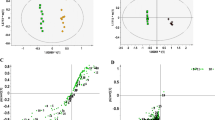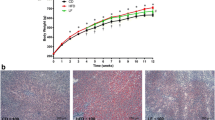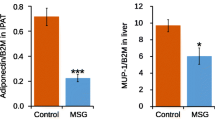Abstract
Obesity, whose prevalence is increasing rapidly worldwide, is recognized as a risk factor for diabetes, cardiovascular disease, liver disease, and renal disease. To investigate metabolic changes in the urine of a rat model of obesity induced by a high-fat diet (HFD), rats were divided into the following four groups based on the diet type and degree of weight gain: normal-diet (ND) low gainers, ND high gainers, HFD low gainers, and HFD high gainers. Biochemical analyses of visceral fat-pad weight, plasma, and liver tissues were performed. The 1H-nuclear magnetic resonance (1H-NMR) spectra of urine were analyzed using multivariate statistical analysis to identify the separation of the groups. It was observed that the metabolic profile of urine obtained by 1H-NMR-spectroscopy-based metabolomic analysis differed between ND low gainers and ND high gainers even though these animals consumed the same normal diet. Several key metabolites in urine, such as betaine, taurine, acetone/acetoacetate, phenylacetylglycine, pyruvate, lactate, and citrate contributed to the classification of these two groups. The metabolic profile of urine also differed between ND low gainers and HFD high gainers, which consumed the different diet and showed a different weight gain. This study has identified features of urine metabolites in various groups and demonstrated the reliability of an NMR-based metabolomics approach to investigate the effects of the diet and the physical constitution on obesity.

Intensity of the metabolites (normalized relative to the creatinine intensity) for ND low gainers vs. HFD high gainers. An independent t test was performed to assess the statistical significance between each group. The error bars are expressed as the SEM *P<0.025 vs. each group




Similar content being viewed by others
References
Hjartåker A, Langseth H, Weiderpass E (2008) Obesity and diabetes epidemics: cancer repercussions. Adv Eup Med Bid 630:72–93
Sowers JR (2003) Obesity as a cardiovascular risk factor. Am J Med 115:37S–41S
Resnick HE, Valsania P, Halter JB, Lin X (2000) Relation of weight gain and weight loss on subsequent diabetes risk in overweight adults. J Epidemiol Community Health 54:596–602
Marchesini G, Moscatiello S, Di Domizio S, Forlani G (2008) Obesity-associated liver disease. J Clin Endocrinol Metab 93:S74–S80
Kramer H (2006) In: Wolf G (ed) Obesity and the kidney. Karger, Basel
OECD Health data 2008 (2008) OECD, Paris, http://www.oecd.org/document/16/0,3343,en_2649_34631_2085200_1_1_1_1,00.html. Assessed 29 May 2009
Fearnside JF, Dumas ME, Rothwelll AR, Wilder SP, Cloarec O, Toye A, Blancher C, Holmes E, Tatoud R, Barton RH, Scott J, Nicholson JK, Gauguier D (2008) Phylometabonomic patterns of adaptation to high fat diet feeding in inbred mice. PLoS ONE 3:e1668
Mutch DM, Clément K (2006) Unraveling the genetics of human obesity. PLoS Genet 2:e188
Tweeddale H, Notley-McRobb L, Ferenci T (1998) Effect of slow growth on metabolism of Escherichia coli, as revealed by global metabolite pool ("metabolome") analysis. J Bacteriol 180:5109–5116
Ott KH, Aranibar N, Singh B, Stockton QW (2003) Metabonomics classifies pathways affected by bioactive compounds. Artificial neural network classification of NMR spectra of plant extracts. Phytochemistry 62:971–985
Maher AD, Cloarec O, Patki P, Craggs M, Holmes E, Lindon JC, Nicholson JK (2009) Dynamic biochemical information recovery in spontaneous human seminal fluid reactions via 1H NMR kinetic statistical total correlation spectroscopy. Anal Chem 81:288–295
Beckonert O, Keun HC, Ebbels TMD, Bundy JG, Holmes E, Lindon JC, Nicholson JK (2007) Metabolic profiling, metabolomic and metabonomic procedures for NMR spectroscopy of urine, plasma, serum and tissue extracts. Nat Protoc 2:2692–2703
Azmi J, Connelly J, Holmes E, Nicholson JK, Shore RF, Griffin JL (2005) Characterization of the biochemical effects of 1-nitronaphthalene in rats using global metabolic profiling by NMR spectroscopy and pattern recognition. Biomarkers 10:401–416
Solanky KS, Bailey NJ, Beckwith-Hall BM, Bingham S, Davis A, Holmes E, Nicholson JK, Cassidy A (2005) Biofluid 1H NMR-based metabonomic techniques in nutrition research metabolic effects of dietary isoflavones in humans. J Nutr Biochem 16:236–244
Shearer J, Duggan G, Weljie A, Hittel DS, Wasserman DH, Vogel HJ (2008) Metabolomic profiling of dietary-induced insulin resistance in the high fat–fed C57BL/6 J mouse. Diabetes Obes Metab 10:950–958
Kozal RA, Nikonoval L, Hoganl J, Riml JS, Mendozal T, Faulkl C, Skaf J, Kozak LP (2006) Changes in gene expression foreshadow diet-induced obesity in genetically identical mice. PLoS Genet 2:e81
Myers MA, Mackay IR, Zimmet PZ (2003) Toxic type 1 diabetes. Rev Endocr Metab Disord 4:225–231
Li H, Ni Yan SuM, Qui Y, Zhou M, Qui M, Zhao A, Zhao L, Jia W (2007) Pharmacometabonomic phenoty** reveals different responses to xenobiotic intervention in rats. J Proteome Res 6:1364–1370
Folch J, Less M, Sloane Stanley GH (1957) A simple method for the isolation and purification of total lipids from animal tissues. J Biol Chem 226:497–509
Akoh CC, Min DB (2008) Food lipids: chemistry, nutrition, and biotechnology, 3rd edn. CRC, Boca Raton
Dunn OJ (1961) Multiple comparisons among means. J Am Stat Assoc 56:52–64
Wei L, Liao P, Wu H, Li X, Pei F, Li W, Wu Y (2008) Toxicological effects of cinnabar in rats by NMR-based metabolic profiling of urine and serum. Toxicol Appl Pharmacol 227:417–429
Barker M, Rayens W (2003) Partial least squares for discrimination. J Chemometrics 17:166–173
Eriksson L, Johansson E, Kettaneh-Wold N, Trygg J, Wikstrom C, Wold S (2006) Multi- and megavariate data analysis part I: basic principles and applications, second revised and enlarged edition. Umetrics, Umea
Webster GT (1942) Cirrhosis of the liver among rats receiving diets poor in protein and rich in fat. J Clin Invest 21:385–392
Best CH, Ridout JH, Lucas CC (1969) Alleviation of dietary cirrhosis with betaine and other lipotropic agents. Can J Physiol Pharmacol 47:73–79
Sugiyama K, Akai H, Muramatsu K (1986) Effects of methionine and related compounds on plasma cholesterol level in rats fed a high cholesterol diet. J Nutr Sci Vitaminol 32:537–549
Huxtable RJ (1992) Physiological actions of taurine. Physiol Rev 72:101–63
Kulakowski EC, Maturo J (1984) Hypoglycemic properties of taurine: not mediated by enhanced insulin release. Biochem Pharmacol 33:2835–2838
Lavoinne A, Baquet A, Hue L (1987) Stimulation of glycogen synthesis and lipogenesis by glutamine in isolated rat hepatocytes. Biochem J 248:429–437
McGarry JD, Foster DW (1980) Regulation of hepatic fatty acid oxidation and ketone body production. Annu Rev Biochem 49:395–420
Phipps AN, Stewart J, Wright B, Wilson ID (1998) Effect of diet on the urinary excretion of hippuric acid and other dietary-derived aromatics in rat. A complex interaction between diet, gut microflora and substrate specificity. Xenoviotica 28:527–537
Delaney J, Neville WA, Swain A, Miles A, Leonard MS, Waterfield CJ (2004) Phenylacetylglycine, a putative biomarker of phospholipidosis: its origins and relevance to phospholipid accumulation using amiodarone treated rats as a model. Biomarkers 9:271–290
Peter J, Turnbaugh RE, Ley MA, Mahowald VM, Elaine RM, Jeffrey IG (2006) An obesity-associated gut microbiome with increased capacity for energy harvest. Nature 444:1027–1031
Bringolf M, Zaragoza N, Rivier D, Felber JP (1972) Studies on the metabolic effects induced in the rat by a high-fat diet. Eur J Biochem 26:360–367
Hagstrom E, Arner P, Ungerstedt U, Bolinder J (1990) Subcutaneous adipose tissue: a source of lactate production after glucose ingestion in humans. Am J Physiol Endocrinol Metab 258:E888–E893
Jansson PA, Larsson A, Smith U, Lönnroth P (1994) Lactate release from the subcutaneous tissue in lean and obese men. J Clin Invest 93:240–246
Rennie MJ, Holloszy JO (1977) Inhibition of glucose uptake and glycogenolysis by availability of oleate in well-oxygenated perfused skeletal muscle. Biochem J 168:161–170
Acknowledgments
This work was supported by the Korea Research Foundation Grant funded by the Korean Government (MOEHRD; KRF-2007-314-C00319)
Author information
Authors and Affiliations
Corresponding author
Rights and permissions
About this article
Cite this article
Kim, SH., Yang, SO., Kim, HS. et al. 1H-nuclear magnetic resonance spectroscopy-based metabolic assessment in a rat model of obesity induced by a high-fat diet. Anal Bioanal Chem 395, 1117–1124 (2009). https://doi.org/10.1007/s00216-009-3054-8
Received:
Revised:
Accepted:
Published:
Issue Date:
DOI: https://doi.org/10.1007/s00216-009-3054-8




